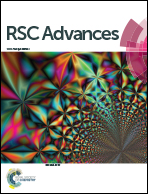Red clover flavonoids protect against oxidative stress-induced cardiotoxicity in vivo and in vitro†
Abstract
Red clover flavonoids (RCF) which contain significant amounts of polyphenolic substances are known for their potential antioxidant properties. However, little is known about their effect on oxidative stress-induced myocardial injury. The objective of this study was to investigate the potential protective effects and mechanisms of RCF on isoproterenol (ISO)-induced myocardial injury in rats and on H2O2-induced apoptosis of H9c2 cardiomyocytes. An in vivo study revealed that RCF (200, 100 and 50 mg kg−1, i.g., respectively) daily for 15 days can prevent ISO-induced myocardial damage, including a decrease of serum cardiac enzymes and improvement in heart vacuolation. RCF also improved the free radical scavenging and antioxidant potential, suggesting one possible mechanism of RCF-induced cardio-protection is mediated by blocking the oxidative stress. An in vitro investigation demonstrated that RCF pretreatment increased cell viability, decreased levels of LDH leakage and PI-positive cells compared with the H2O2 group. Moreover, RCF pretreatment inhibited cell apoptosis, as evidenced by improved mitochondrial membrane potential disruption, decreased caspase-3 level, as well as increased Bcl-2/Bax ratio. Further mechanism investigation revealed that RCF prevented H9c2 cardiomyocytes injury and apoptosis induced by MAPK pathways. These results suggest that RCF exerted cardioprotective effects against myocardial injury by inhibiting oxidative stress, cardiac myocyte apoptosis, and modulating MAPK pathways, indicating that RCF might be a potential agent in the treatment of heart disease.


 Please wait while we load your content...
Please wait while we load your content...